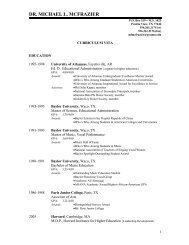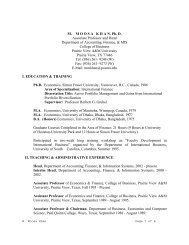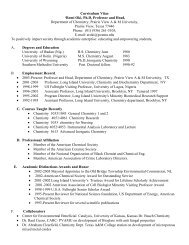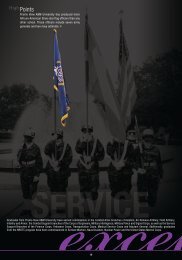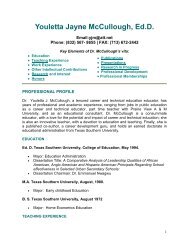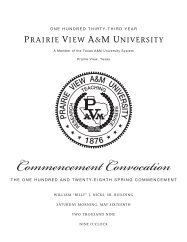Addressing Medical School Diversity Through an Undergraduate ...
Addressing Medical School Diversity Through an Undergraduate ...
Addressing Medical School Diversity Through an Undergraduate ...
Create successful ePaper yourself
Turn your PDF publications into a flip-book with our unique Google optimized e-Paper software.
<strong>Diversity</strong> Issues<br />
background to ensure that they are<br />
competitive medical school applic<strong>an</strong>ts<br />
<strong>an</strong>d that they successfully complete the<br />
basic sciences curriculum in medical<br />
school.<br />
Lessons Learned <strong>an</strong>d Future<br />
Challenges<br />
The UMA’s overall retention rate has<br />
been 91.7%, with students leaving the<br />
program for numerous reasons,<br />
including ch<strong>an</strong>ges in career goals <strong>an</strong>d<br />
failure to meet the GPA requirements.<br />
The first class of UMA students<br />
graduated in May 2007, with a successful<br />
medical school accept<strong>an</strong>ce rate of 64%<br />
(7 of 11 students) compared with<br />
accept<strong>an</strong>ce rates of 24% (personal<br />
communication, Mr. Filomeno G.<br />
Maldonado, Assist<strong>an</strong>t De<strong>an</strong> for<br />
Admissions A&M College of Medicine,<br />
May 2007) <strong>an</strong>d 38% 8 for Afric<strong>an</strong><br />
Americ<strong>an</strong> students in Texas <strong>an</strong>d<br />
nationwide, respectively, in the same<br />
year. In addition, this percentage is<br />
higher th<strong>an</strong> the overall medical school<br />
applic<strong>an</strong>t accept<strong>an</strong>ce rate of 45%. 9<br />
This program is clearly in its inf<strong>an</strong>cy <strong>an</strong>d<br />
remains a work in progress. However,<br />
there are several strategies we have<br />
identified that c<strong>an</strong> be applied to<br />
partnerships between other medical<br />
schools <strong>an</strong>d minority undergraduate<br />
institutions. We find that the most<br />
critical feature is a geographical<br />
proximity between the two campuses that<br />
allows for personal interactions between<br />
faculty <strong>an</strong>d students. Although the<br />
AAMC AspiringDocs campaign identifies<br />
dist<strong>an</strong>ce education as a key component,<br />
in our experience the import<strong>an</strong>ce of a<br />
physical presence of the medical school<br />
faculty, students, <strong>an</strong>d staff on the<br />
undergraduate campus c<strong>an</strong>not be<br />
overstated. Our joint admissions process,<br />
which involves faculty <strong>an</strong>d staff from the<br />
UMA <strong>an</strong>d the A&M College of Medicine,<br />
places both partners in <strong>an</strong> “ownership”<br />
position; this establishes <strong>an</strong> immediate<br />
commitment for student success by both<br />
the medical school <strong>an</strong>d the undergraduate<br />
institution. Our experience is consistent<br />
with previous reports suggesting that<br />
positive factors influencing the medical<br />
school accept<strong>an</strong>ce rate for students at<br />
HBCUs include a strong affiliation<br />
between the school <strong>an</strong>d a medical<br />
school. 10 At this point, a class size of 20 to<br />
25 has been <strong>an</strong> optimal number to<br />
provide personalized academic support<br />
<strong>an</strong>d effective faculty-to-student ratios.<br />
This number is based on available space<br />
(rooms to facilitate small-group<br />
tutoring), the staff-to-student ratio for<br />
academic counseling, <strong>an</strong>d funding to<br />
support student scholarships. Finally,<br />
providing <strong>an</strong> opportunity for medical<br />
students to interact with the undergraduate<br />
students has been a key component<br />
in our success; the role of student<br />
mentorship is of utmost import<strong>an</strong>ce.<br />
We have made a promising start toward<br />
achieving our goal of better preparing<br />
minority students for the challenges of<br />
medical school, but we continue to face<br />
challenges along the way, including<br />
identifying <strong>an</strong>d securing additional<br />
funding for the summer program <strong>an</strong>d<br />
optimizing strategies that will improve<br />
student perform<strong>an</strong>ce on the MCAT.<br />
Although work remains, the goal of<br />
increasing diversity in our medical<br />
schools <strong>an</strong>d, ultimately, in the physici<strong>an</strong><br />
workforce, dem<strong>an</strong>ds our attention <strong>an</strong>d<br />
the continued development of innovative<br />
programs to meet the challenge.<br />
Acknowledgments<br />
The authors wish to acknowledge gr<strong>an</strong>t support<br />
from the Texas Higher Education Coordinating<br />
Board.<br />
References<br />
1 Cohen JJ, Gabriel BA, Terrell C. The case for<br />
diversity in the health care workforce. Health<br />
Aff (Millwood). 2002;21:90–102.<br />
2 Cohen JJ. Increasing diversity in the medical<br />
workforce is one solid way to prevent disparities<br />
in health care. MedGen Med. 2005;7:26.<br />
3 Fincher RM, Sykes-Brown W, Allen-Noble R.<br />
Health science learning academy: A successful<br />
“pipeline” educational program for high<br />
school students. Acad Med. 2002;77:737–738.<br />
4 Grumbach K, Chen E. Effectiveness of<br />
University of California postbaccalaureate<br />
premedical programs in increasing medical<br />
school matriculation for minority <strong>an</strong>d<br />
disadv<strong>an</strong>taged students. JAMA. 2006;296:<br />
1079–1085.<br />
5 Rom<strong>an</strong> SA. <strong>Addressing</strong> the urb<strong>an</strong> pipeline<br />
challenge for the physici<strong>an</strong> workforce: The<br />
Sophie Davis model. Acad Med. 2004;79:<br />
1175–1183.<br />
6 Association of Americ<strong>an</strong> <strong>Medical</strong> Colleges.<br />
Aspiring Docs.Org. Available at: (http://www.<br />
aamc.org/diversity/aspiringdocs/aspiringdocs.<br />
pdf). Accessed J<strong>an</strong>uary 28, 2007.<br />
7 Texas Legislature Online. Legislation history.<br />
Available at: (http://www.legis.state.tx.us/<br />
BillLookup/History.aspx?LegSess78R&Bill<br />
HB85). Accessed J<strong>an</strong>uary 28, 2007.<br />
8 Association of Americ<strong>an</strong> <strong>Medical</strong> Colleges.<br />
FACTS. Table 12: Applic<strong>an</strong>ts, First-Time<br />
Applic<strong>an</strong>ts, Acceptees, <strong>an</strong>d Matricul<strong>an</strong>ts to<br />
U.S. <strong>Medical</strong> <strong>School</strong>s by Hisp<strong>an</strong>ic or Latino<br />
Ethnicity, Non-Hisp<strong>an</strong>ic or Latino Race, <strong>an</strong>d<br />
Sex, 2005–2007. Available at: (http://www.<br />
aamc.org/data/facts/2007/0507sumyrs.htm).<br />
Accessed J<strong>an</strong>uary 28, 2007.<br />
9 Association of Americ<strong>an</strong> <strong>Medical</strong> Colleges.<br />
FACTS. Table 7: Applic<strong>an</strong>ts, First-Time<br />
Applic<strong>an</strong>ts, Acceptees, <strong>an</strong>d Matricul<strong>an</strong>ts to<br />
U.S. <strong>Medical</strong> <strong>School</strong>s by Sex, 1996–2007.<br />
Available at: (http://www.aamc.org/data/<br />
facts/2007/2007summary2.htm). Accessed<br />
J<strong>an</strong>uary 28, 2007.<br />
10 Atkinson DD, Spratley E, Simpson CE.<br />
Increasing the pool of qualified minority<br />
medical school applic<strong>an</strong>ts: Premedical training<br />
at historically black colleges <strong>an</strong>d universities.<br />
Public Health Rep. 1994;109:77–85.<br />
Academic Medicine, Vol. 83, No. 5 / May 2008 515


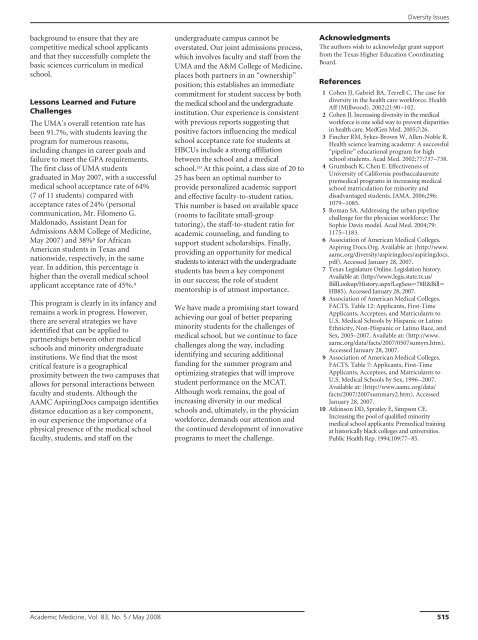
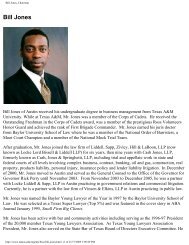
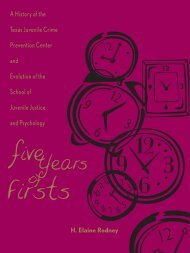
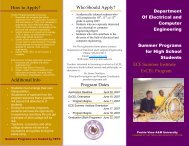
![[5a]Resume for Dr. O..](https://img.yumpu.com/42719681/1/190x245/5aresume-for-dr-o.jpg?quality=85)



